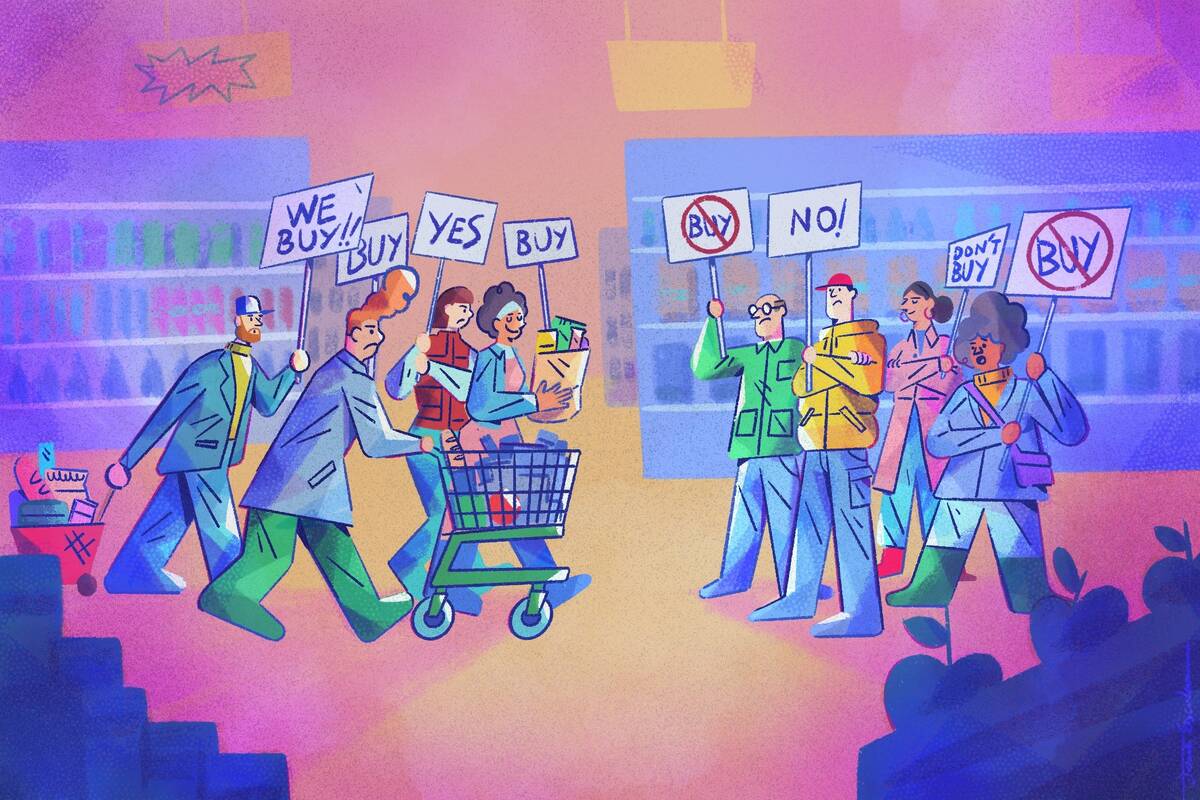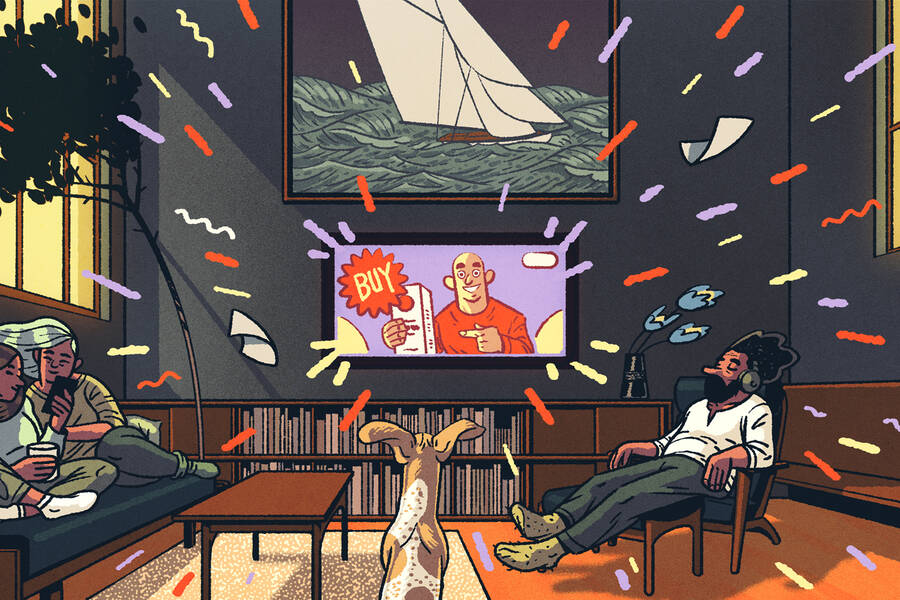Marketing Jan 1, 2023
How Much Do Boycotts Affect a Company’s Bottom Line?
There’s often an opposing camp pushing for a “buycott” to support the company. New research shows which group has more sway.

Jesús Escudero
When a company you like takes a political stance that you oppose—or the CEO makes a statement you disagree with—you may feel pressured to join a boycott.
But will it get the results you want?
After all, for every punch thrown on the internet, someone is ready with a counterpunch. Another camp, supportive of the policy or politician, may urge their followers to go shopping. That opposing move is called a buycott.
Anna Tuchman, a professor of marketing at Kellogg, wanted to find out what really happens to consumer behavior —and sales—when a company finds itself in a political social media storm. “While there have been a lot of boycotts in the past, there are more buycotts happening now,” she says.
Business leaders want to understand how social media outrage affects their bottom line, Tuchman says. Earlier research mainly looked at boycotts, but Tuchman was interested in the more comprehensive view of the impact of simultaneous boycotts and buycotts.
When Tuchman and her coauthors, Jūra Liaukonytė of Cornell University and Xinrong Zhu of Imperial College, dove deep into one company’s experience, they found the buycott effect swamped the boycott action, and sales actually increased. But the impact evaporated in just a few weeks.
It’s a counterintuitive result, Tuchman says. Calls for a boycott often outnumber those voices who offer the company support on social media or in news articles. “In the absence of sales data, you’d think it’s probably catastrophic for the brand.”
How much impact do boycotts really have?
In July 2020, Robert Unanue, the CEO of Latin food purveyor Goya—who had previously hit a nerve with his inflammatory remarks about immigration—praised then-President Trump during a meeting at the White House. The comments triggered immediate backlash, and many Latino leaders called for a boycott. The hashtags #Goyaway and #BoycottGoya trended on Twitter.
Meanwhile, Trump supporters started a #BuyGoya and #BuycottGoya countermovement.
At the time, the impact on the company of #BoycottGoya versus #BuycottGoya was as clear as black-bean soup. Media reports predicted calamity for the company: media outlets posted over 1,500 stories with Goya in the headline, and only 18 mentioned the buycott; and calls for a boycott far outnumbered calls for a buycott on Twitter. Yet Unanue claimed sales were up 1,000 percent.
Research shows there is a political divide among U.S. consumers in their brand preferences.
To find out the actual impact on sales, Tuchman and coauthors obtained detailed shopping data from the market-research company Numerator for 33,486 households that purchased a Goya product at least once between January 2019 and December 2020. The information included dates of shopping trips and the quantity, prices, brand name, and parent brand of each purchased product. The data also included demographic information such as household size, income bracket, age, race/ethnicity, and zip code. The researcherss were able to match the households to county-level voting statistics from the 2020 presidential election.
Over a two-week period immediately after the CEO’s remarks, 16.9 percent of buyers who bought Goya products were first-time Goya buyers—evidence of the buycott’s impact. The buycott movement disproportionately brought in first-time Goya buyers from heavily Republican areas—sales increased by 56.4 percent in heavily Republican counties.
Meanwhile, “we find that the brand’s most valuable customers, Latinos, did not decrease their purchases of Goya products, despite vocal support for the boycott movement from prominent Latino figures,” the paper points out.
Altogether, the buycott effect overwhelmed the boycott effect, raising Goya’s sales 22 percent during the two-week period. But the impact was temporary; there was no detectable sales increase after three weeks. (In their analyses, the researchers controlled for the effects of seasonal variations, price changes, holiday impacts, and the longer-term increase in sales driven by the pandemic.)
Why didn’t the boycott have a bigger impact?
Of course, the Goya boycott and buycott took place within the larger context of U.S. political polarization. Research shows there is a political divide among U.S. consumers in their brand preferences—a divide that only increased after the election of Donald Trump.
Tuchman and her coauthors calculated that, pre-scandal, of 300 top consumer-packaged-goods brands, Goya was the most Democratic, based on the high concentration of its customers in left-leaning counties.
This makes it a somewhat unusual case. “In the majority of cases, when brands take political stances, they are trying to give their core customer base what they want to hear,” Tuchman says. “In this case, the message touted by the CEO was actually in opposition to the preferences of many of the core customers.”
So what accounted for Goya’s customers’ loyalty during the boycott? Tuchman points out that brand loyalty can be powerful—particularly for products that do not have an equivalent substitute, such as Goya’s Adobo seasoning.
And, in one important way, the failure of the boycott in the face of a buycott was completely predictable, Tuchman points out. Only seven percent of American households were already buying Goya products regularly and could effectively take part in a boycott. In contrast, any shopper can participate in a buycott.
As for buycotters, the stakes of switching grocery-store brands are pretty low: you can always switch back. Buycotts on higher-ticket items, where consumers are likely to be more risk-averse, may be less effective.
Finally, grocery-store brands are not highly visible signifiers of political identity. “No one knows what brand of beans your family buys,” Tuchman says. Products that are more visible, such as clothes or cars with a brand logo, may see a larger or longer-term impact from boycotts or buycotts.
What can company leaders learn from Goya’s experience?
Tuchman is quick to say the Goya case may be unique, not least because Goya is a private, family-owned business, so its CEO can say whatever he wants without blowback from shareholders or a board of directors.
But the extreme political difference between Goya’s CEO and his core customers provides strong empirical evidence that a boycott does not equate to a poor business outcome if a buycott is also in effect, Tuchman says.
She and colleagues are currently investigating how other companies fare during boycotts. For example, Tuchman recently published data showing a boycott of the audio-streaming-service Spotify did not stop growth in its subscriber base.
There is one potentially confounding factor that Tuchman and other researchers say needs to be examined. When a brand is in the news or trending on social media, the wave of publicity may act like advertising to boost sales, meaning people may be more likely to buy a product not because they’re actively participating in the buycott, but because they’ve heard the brand name a lot recently.
While business leaders shouldn’t assume their experience in a boycott will be the same as Goya’s, they can still take comfort in these results, Tuchman says.
“I’d feel a sense of relative calm knowing that the building evidence suggests, even when there is a big scandal, the effects don’t seem to last very long,” she says.
Melody Bomgardner is a freelance writer in Bend, Oregon.
Liaukonytė, Jūra, Anna Tuchman, and Xinrong Zhu. 2022. “Frontiers: Spilling the Beans on Political Consumerism: Do Social Media Boycotts and Buycotts Translate to Real Sales Impact?” Marketing Science.
Liaukonytė, Jūra, Anna Tuchman, and Xinrong Zhu. 2022. “Rejoinder: Spilling More Beans on Political Consumerism: It’s More of the Same Tune.” Marketing Science.



